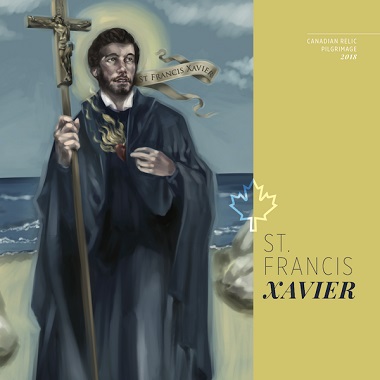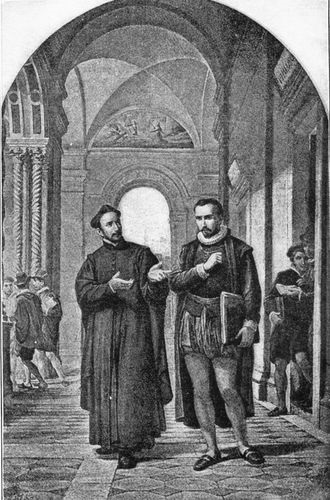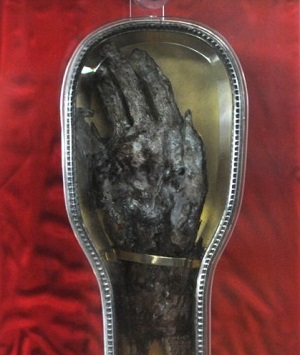
The St. Francis Xavier Relic Pilgrimage will be at two churches in Metro Vancouver January 24 – 25. CCO image.
How often do missionaries garner serious press attention these days? Never, unless they are held prisoner for years in some totalitarian nation. Good works and sacrificial living don’t make the front page. But the St. Francis Xavier Relic Pilgrimage is receiving all kinds of coverage as it makes its way across Canada.
The relic – the right forearm and hand of St. Francis Xavier – will be on display in 15 cities across Canada this month. The two local stops are St. Francis Xavier Catholic Church in Vancouver (January 24) and All Saints Catholic Church in Coquitlam (January 25).
Coverage has been quite positive. A January 16 CBC News story, for example, noted:
Both the faithful and the curious descended on the [Winnipeg] church as the 465-year-old relic stopped there on Tuesday, part of a cross-country tour expected to be attended by 75,000 Canadians when all is said and done.
“I think the people come to an event like this expecting to have a spiritual experience,” said Father John O’Brien. “It’s very Catholic to have a spiritual experience through tangible things, and there’s nothing more tangible than the bones of a saint.”
A January 11 article in The Vancouver Sun gave a good account of both the significance of the man and the purpose of the tour.
A missionary giant
There is no doubt about the significance of St. Francis Xavier. Stephen Neill, in A History of Christian Missions, said:
One of the first companions of Ignatius Loyola was the Basque Francis Xavier (1506-52), who was to become the most famous of all Roman Catholic missionaries, and one of the greatest missionaries in the whole history of the Church.
He also pointed out that the two men and four other friends founded the Jesuit Order, “perhaps the most important event in the missionary history of the Roman Catholic Church.”
Sponsors of the tour
Three groups are working together to sponsor the St. Francis Relic Pilgrimage – the Jesuits in Canada, Catholic Christian Outreach (CCO) and the Archdiocese of Ottawa. Here is how they describe the tour:
The relic pilgrimage is a gift for the Church in Canada at the close of our 150th anniversary year, bringing the famous relic of St. Francis Xavier to North America for the first time in generations. This is a once-in-a-lifetime opportunity to venerate the incorrupt first class relic of one of the greatest missionaries and evangelists since St. Paul the Apostle.
We anticipate three particular extraordinary graces in this pilgrimage, all related to the charisms of St. Francis Xavier: (1) conversion of souls; (2) the raising up of missionary disciples who are abandoned to God’s will; and (3) healing. Our prayer is that – through this relic pilgrimage – you will have the unique opportunity to personally encounter the tender heart of Jesus.
Who was St. Francis Xavier?

St. Ignatius Conversing with St. Francis Xavier at the University of Paris.
This is from the Jesuit site:
St. Francis Xavier was born in Navarre, Spain, on April 7, 1506. After completing studies in Spain, he traveled to Paris in 1525, where he befriended Peter Faber and Ignatius Loyola. The three men, along with future Jesuits James Lainez, Alfonso Salmerón, Nicholas Bobadilla and Simón Rodrigues, professed vows of poverty and chastity in Montmartre on August 15, 1534.
Xavier and Ignatius were both ordained on June 24, 1537. In April 1541, Xavier sailed to India on a dangerous voyage, landing at Goa in May 1542 to evangelize the people of the East Indies. He spent the first five months preaching and ministering to the sick. He then journeyed to the southern coast, aiming to restore Christianity. He devoted almost three years to preaching to the people of Western India, converting many.
Xavier embarked for Japan in June 1549, where he devoted the entire first year to learning the Japanese language. During his stay in Japan, Xavier heard much about the Chinese and saw it as his next opportunity to spread the Gospel. He sailed to China in 1552, landing at the small island of Shangchuan off the coast. Before reaching the mainland, however, he became ill and died on the island on December 3, 1552.
He completed a staggering amount of missionary work in just 10 years, earning him the titles ‘Apostle of the Indies’ and ‘Apostle of Japan.’ He was canonized with St. Ignatius in 1622 by Pope Gregory XV and named the patron saint of all foreign missions by Pope Pius X.
His body is still enshrined at Goa in the Basilica of Bom Jesus. In 1614, by the order of Jesuit Superior General Claudio Acquaviva, his right arm was severed at the elbow and taken to Rome, where an altar was made to display it in the Church of the Gesù.
Some perspective
Ruth A. Tucker, devoted several pages to Xavier’s “short but extraordinary missionary career” in From Jerusalem to Irian Jaya: A Biographical History of Christian Missions. Her book is notable for its willingness to deal with weaknesses as well as strengths – and that applies to missionaries of all backgrounds.
She notes, for example:
Xavier’s evangelism in India was superficial at best. Whether the children and adults he baptized even knew the most fundamental truths of Christianity is doubtful.
As well, he was not particularly sympathetic to the Indian culture he was exposed to. Referring to his child converts, he said (here Tucker draws from a biography by James Brodrick SJ, who quoted Xavier):
They detest the idolatries of their people, and get into fights with them on the subject. They tackle even their own parents if they find them going to the idols, and come to tell me about it. . . . The little fellows seize the small clay idols, smash them, grind them to dust, spit on them and trample them underfoot.
(Brodrick is described on the Jesuits in Britain site as “one of the [Jesuit] Society’s great historians. . . . His obituary in the Times observed that his greatest contribution to Roman Catholic tradition was ‘rescuing the early Jesuit saints from the hagiographers and apologists and subjecting them to historical criticism. In the process he brought them to life and brought new insights to bear on the Counter Reformation period.'”)
Stephen Neill pointed out that Xavier matured in his approach to missions as a result of his time in Japan:
These early contacts with the Japanese produced a change in Xavier’s understanding of the nature of Christian missionary work which was to be of the greatest significance for the whole future of the enterprise.
In earlier years he had been inclined to accept uncritically the doctrine of the tabula rasa – the view that in non-Christian life and systems there is nothing on which the missionary can build, and that everything must simply be levelled to the ground before anything Christian can be built up. This was the general view of the Spanish missionaries in Latin America and West Indies; in his dealings with the simple and illiterate fishers in south India, Xavier had seen no reason to modify it.
But now that he was confronted by a civilization with so many elements of nobility in it, he saw that while the Gospel must transform and refine and recreate, it need not necessarily reject as worthless everything that has come before. This new idea was to be fruitful in results – and also in controversies.
(To be reminded just how current those issues still are, consider the impressive new book Protestants Abroad: How Missionaries Tried to Change the World but Changed America.)
Why relics?

St. Francis Xavier’s severed right forearm and hand. CCO image.
The CCO site talks about relics:
What is significant about this relic?
This relic is the right forearm and hand of St. Francis Xavier. It is estimated he baptized more than 100,000 people with this arm. . . . His arm, as well as the rest of his body, is incorrupt. Saints are referred to as incorrupt when their body, miraculously, does not experience natural decay. It has been 465 years since his death.
Why venerate relics?
The veneration of relics is a longstanding practice inside and outside the Catholic Church. Within Christianity, the practice rests on the belief that God came to humanity in the flesh, namely in the physical person of Jesus of Nazareth. Important sacraments of the faith also include water, wine and bread – physical elements that take on spiritual, supernatural value and characteristics. Similarly, the relics of saints provide for a tangible experience of God’s graces. As well, Catholics believe that saints can intercede for humanity, given their proximity to God in what is commonly referred to as the “Communion of Saints” or the Mystical Body of Christ.
There are analogies to this in our human experience. When we have lost a loved one, going to their places and touching their favourite things evoke reverence, affection and connection to them.
The relics of saints provide an incarnational experience of God’s graces. As Catholics, we believe that, in the Communion of Saints, we can turn to the saints to pray on our behalf. There are various levels of relics:
- Body/bones of a saint (first class)
- Objects/clothing that belonged to a saint (second class)
- Objects that touch a first-class relic (third class)
Relics, in a tangible way, provide an opportunity for a special connection with that saint because their body matters to God and someday will be reunited with their soul.
We do not worship, we do not adore, for fear that we should bow down to the creature rather than to the Creator, but we venerate the relics of the martyrs in order the better to adore Him whose martyrs they are. – St. Jerome
Missionary consciousness-raising
This is a great week for anyone interested in missions. First St. Francis Xavier, then Missions Fest (January 26 – 28).
Paul Schratz, who oversees communications for the Archdiocese of Vancouver and edits The B.C. Catholic, wrote Canada awaits St. Francis Xavier:
I think Canada’s ready for St. Francis Xavier.
Simply from a public spectacle viewpoint, the arrival of the evangelizing saint’s relic has caught the public’s eye.
The visiting arm of St. Francis Xavier has already received an extraordinary amount of media attention, from national TV and radio interviews to newspaper features. I can’t explain it. Maybe the media, despite their secular framing of the world, are experiencing a sense of some other, inexplicable dimension out there, and they’re willing to dip an exploratory toe into it. . . .
I plan to go to St. Francis Xavier Parish to pay my respects to a brave, devoted and pioneering missionary. I remain a relics skeptic, but I will do my darndest to think sacramentally and keep my mind open.
I hope others who attend will also go to Missions Fest. The missionaries there won’t seem so grand (I suppose most of them aren’t), but I have met some impressive people over the years. For example:
- Dr. Helen Roseveare, who worked as a medical missionary in the Congo from 1953 to 1973. She survived rape and trial during the Congolese civil war in the 1960s.
- Bruce Olson, who walked into the jungles of Venezuela at the age of 19 to work with the Motilone Indians. He tells his story in Bruchko and Bruchko and the Motilone Miracle.
- Dr. Jean Buchan, a Scottish-born medical missionary who administered a women’s medical clinic in impoverished Bansi, northeastern India for some 60 years. She attended Sapperton Baptist Church in New Westminster when she was home. Her obituary says she was remembered as Canada’s Mother Teresa – how short our memories are!
And I’m sure some of the real treasures are too quiet to get noticed at all. Even the ones who have major flaws in their worldviews have great stories and are worthy of much respect.
This year I’m looking forward to hearing from Jarrod McKenna who, according to The Guardian (November 27, 2017), was one of several “Christian leaders have chained themselves to the front gates of the prime minister’s official Sydney residence to protest against Australia’s treatment of refugees and asylum seekers on Manus Island.”
